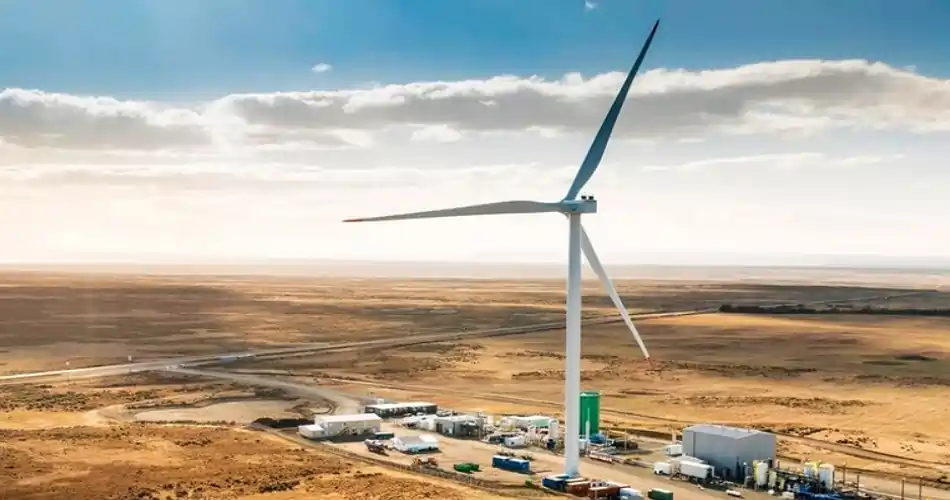The process involves obtaining hydrogen from green energy and combining it with carbon present in the atmosphere.
E-fuel is suitable for all combustion-engine vehicles that will remain on the road, including classics and racing cars. It is being considered as one of the alternative options to the total electrification of vehicles. Its production is taking its first steps, and although it is necessary to clarify aspects such as its final price, its energy efficiency and its neutrality in CO2 emissions, the project of the production plant of this type of fuel of Porsche in Patagonia has already achieved positive results.
The company justifies the fact that in Germany, for example, wind turbines operate at full capacity only 66 days a year on average. According to Bundesnetzagentur (federal grid agency), they supplied 25.9 % of the electricity consumed in 2022. In electric vehicles, a share of this renewable energy plays a key role in the life cycle assessment of mobility. But there are currently some 1.3 billion vehicles with internal combustion engines in use worldwide and they will continue to be on the road for many years to come. Environmentally friendly operation will require other solutions, such as so-called e-fuels, which are synthetic fuels produced in a virtually carbon-neutral way.
Porsche is doing its part, with a new production plant in South America, located in Punta Arenas. A town that has some 130,000 inhabitants and is located in the Patagonia region in the far south of Chile, making it the southernmost large city in the world. It is also the most important commercial center of the western coast of the Strait of Magellan.
This area is known for the strong winds that blow incessantly, almost always in the same direction. They are so powerful that they can transform trees into strange sculptures, which are called “flag trees”. Wind turbines could operate at full capacity 270 days a year here, yet the region hardly uses wind power at all. Porsche wants to tap this resource with international partners and has an 11.6 % stake in the Chilean company Highly Innovative Fuels (HIF). The aim is to use wind energy there to manufacture synthetic fuels. Inaugurated in December 2022, the production plant located near Punta Arenas is called Haru Oni, which in the local dialect means “land of winds”. The production schedule for the current pilot phase is 130,000 liters per year of e-fuel.
Air and water fuel
The first step in the manufacture of e-fuels is electrolysis for hydrogen production. It requires a large amount of energy, which is what makes the perpetual availability of green electricity so important. Water (H₂O) is a very stable chemical compound. Two hydrogen (H) atoms bond with an oxygen (O) atom to form that molecule. A large amount of energy is needed to separate the hydrogen from this compound. As the Patagonian wind offers inexhaustible energy, hydrogen can be generated there in a more sustainable and affordable way. In regions where energy is limited, all electricity must be used directly for maximum yield.
In addition to hydrogen, production requires a second component, carbon dioxide (CO₂). This is a greenhouse gas that, in high concentrations in the atmosphere, causes global warming. CO₂ can be separated from the air by direct capture. It consists of passing the air passes through a ceramic filter, similar to the catalytic converter in a car. However, instead of precious metals, the flow channels use a chemical substance to retain the CO₂ molecules. Once all the spaces are filled with CO₂, the filter is closed and heated. The heat releases the CO₂, which can be sucked into a tank. Specifically, one liter of e-fuel requires the hydrogen from three liters of desalinated seawater and the CO₂ from 6,000 cubic meters of air.
A synthesis plant then joins the hydrogen and CO₂ to create methanol, a highly durable fuel suitable for storage and transportation. Currently, ship engines are designed to run on methanol. However, use in passenger cars requires performing an additional process, with carbon compounds added in the final step of the synthesis: from methanol to gasoline. The end product is an alternative to gasoline and diesel, and can also be blended with conventional mineral oil-based fuels. Another way to further reduce emissions.
The objective
Thus, the fuel produced in Chile consists of nothing more than air and water. It could be distributed to gas stations all over the world. It should also be noted that all internal combustion engines can run on this type of fuel, from classic cars to racing cars.

